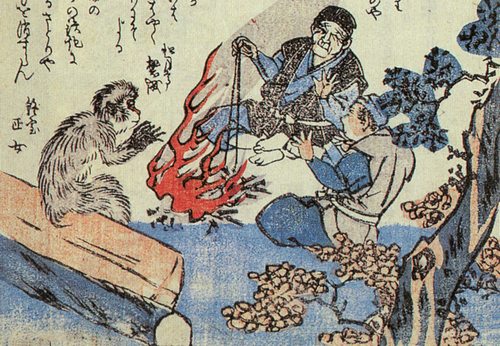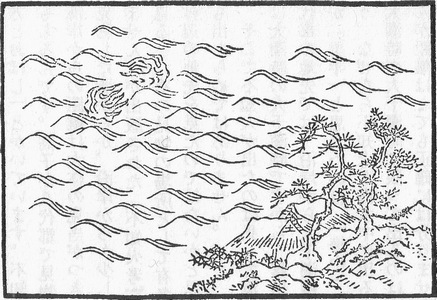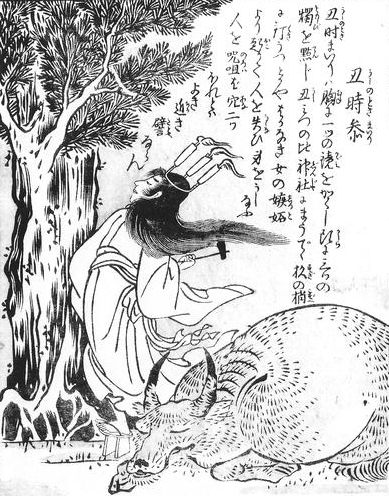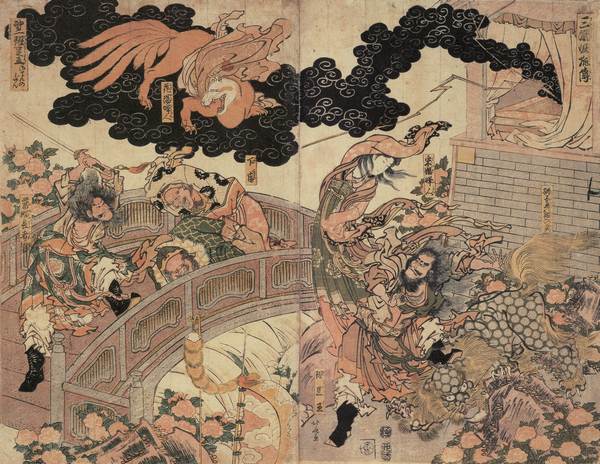|
Konjaku Gazu Zoku Hyakki
is the second book of Japanese artist Toriyama Sekien's famous ''Gazu Hyakki Yagyō'' tetralogy, published c. 1779. A version of the tetralogy translated and annotated in English was published in 2016. These books are supernatural bestiaries, collections of ghosts, spirits, spooks, and monsters, many of which Toriyama based on literature, folklore, other artwork. These works have had a profound influence on subsequent ''yōkai'' imagery in Japan. ''Konjaku Gazu Zoku Hyakki'' is preceded in the series by ''Gazu Hyakki Yagyō'', and succeeded by ''Konjaku Hyakki Shūi'' and ''Gazu Hyakki Tsurezure Bukuro''. List of creatures The three volumes were titled 雨, 晦, and 明. From this book, Toriyama added captions. First Volume – 雨 (Rain) Image:SekienOmagatoki.jpg, Image:SekienOni.jpg, Image:SekienSansei.jpg, Image:SekienHiderigami.jpg, Image:SekienSuiko.jpg, Image:SekienSatori.jpg, Image:SekienShuten-doji.jpg, Image:SekienHashihime.jpg, Image:SekienHannya.jpg, I ... [...More Info...] [...Related Items...] OR: [Wikipedia] [Google] [Baidu] |
Japan
Japan ( ja, 日本, or , and formally , ''Nihonkoku'') is an island country in East Asia. It is situated in the northwest Pacific Ocean, and is bordered on the west by the Sea of Japan, while extending from the Sea of Okhotsk in the north toward the East China Sea, Philippine Sea, and Taiwan in the south. Japan is a part of the Ring of Fire, and spans Japanese archipelago, an archipelago of List of islands of Japan, 6852 islands covering ; the five main islands are Hokkaido, Honshu (the "mainland"), Shikoku, Kyushu, and Okinawa Island, Okinawa. Tokyo is the Capital of Japan, nation's capital and largest city, followed by Yokohama, Osaka, Nagoya, Sapporo, Fukuoka, Kobe, and Kyoto. Japan is the List of countries and dependencies by population, eleventh most populous country in the world, as well as one of the List of countries and dependencies by population density, most densely populated and Urbanization by country, urbanized. About three-fourths of Geography of Japan, the c ... [...More Info...] [...Related Items...] OR: [Wikipedia] [Google] [Baidu] |
Satori (folklore)
in Japanese folklore are mind-reading monkey-like monsters ("yōkai") said to dwell within the mountains of Hida and Mino (presently Gifu Prefecture). Mythology People are said to meet them while walking along mountain paths or resting in the mountains. Upon reading a person's mind, the satori would say the person's thoughts aloud faster than a human could. There is also a theory that they are the child incarnations of mountain gods who have come to ruin and turned into a yōkai form. They would appear before people at mountain huts, and are even said to try to eat and kill if they have a chance, but if something unexpectedly strikes the satori, they become stricken with fear and run away. There is also a theory that they do not present any danger to people and would not dare to harm those who work on the mountain, allowing people to coexist with satori. A satori is depicted in Toriyama Sekien's ''Konjaku Gazu Zoku Hyakki'', but since this was modeled after the yamako (玃) i ... [...More Info...] [...Related Items...] OR: [Wikipedia] [Google] [Baidu] |
Shiranui
is an atmospheric ghost lights, atmospheric ghost light told about in Kyushu. They are said to appear on days of the noon moon such the (29th or 30th day) of the seventh month of the lunisolar Japanese calendar when the wind is weak, in the Yatsushiro Sea and the Ariake Sea. The phenomenon persists in the present day, with the strange lights having been determined to be an Optical phenomenon#Atmospheric optical phenomena, atmospheric optical phenomenon. Summary The phenomenon occurs several kilometers out from the shore in open water. First, one or two flames (called "oyabi" (親火, lit. "parent-fire")) will appear. These will split off to the left and right and multiply, eventually producing anywhere from several hundred to several thousand flames in a row. They are said to span four to eight kilometers. It is believed that the greatest number of shiranui can be seen at the lowest tide, within two hours of 3:00AM. They are said to be invisible from the water's surface and ... [...More Info...] [...Related Items...] OR: [Wikipedia] [Google] [Baidu] |
Ushi No Toki Mairi
or refers to a prescribed method of laying a curse upon a target that is traditional to Japan, so-called because it is conducted during the hours of the Ox (between 1 and 3 AM). The practitioner—typically a scorned woman—while dressed in white and crowning herself with an iron ring set with three lit candles upright, hammers nails into a of the Shinto shrine. In the modern-day common conception, the nails are driven through a straw effigy of the victim, impaled upon the tree behind it. The ritual must be repeated seven days running, after which the curse is believed to succeed, causing death to the target, but being witnessed in the act is thought to nullify the spell. The Kifune Shrine in Kyoto is famously associated with the ritual. Also variously called , , . Overview Sources say that common method of the ritual developed during the Edo period (1603–1868)., citing The woman performing the curse is generally portrayed as dressed in white, with disheveled hai ... [...More Info...] [...Related Items...] OR: [Wikipedia] [Google] [Baidu] |
Osakabe
Osakabehime (刑部姫) is a figure in Japanese folklore. She is described as a yōkai inhabiting Himeji Castle. A Kabuki play based on her story is considered one of the Shin-Kabuki Jūhachiban. Legend Osakabehime lives in the castle tower of Himeji Castle, and meets the castle lord only once a year to tell him the fate of the castle. According to Matsuura Shizuyama's essay ''Kasshi Yawa'', the reason why Osakabehime lives in hiding like this is because she hates people. The true identity of Osakabehime is generally considered to be an old kitsune, or an unrighteous child born by Princess Inoe to his son Osabe-shinno, There are also theories such as the claim she is the spirit of the courtesan that Emperor Fushimi loved or Osakabe Okami, the god of Mt Hime, where Himeji Castle is located. Gender of this yōkai was not clearly determined in ''Shokokuhyakumonogatari'' (appeared in various forms including men and women), but eventually they came to be considered a woman. It i ... [...More Info...] [...Related Items...] OR: [Wikipedia] [Google] [Baidu] |
Tamamo-no-Mae
Tamamo-no-Mae (, , also ) is a legendary figure in Japanese mythology. One of the stories explaining the legend comes from Muromachi period genre fiction called '' otogizōshi''. In the otogizōshi Tamamo-no-Mae was a courtesan under the Japanese Emperor Konoe (who reigned from 1142 through 1155). Legends Stories of Tamamo-no-Mae being a legendary fox spirit appear during the Muromachi period as otogizōshi (prose narratives), and were also mentioned by Toriyama Sekien in ''Konjaku Hyakki Shūi''. Edo period folklore then conflated the legend with similar foreign stories about fox spirits corrupting rulers, causing chaos in their territories. In the story told by Hokusai, formed in the Edo period, the nine-tailed fox first appeared in China and possessed Daji, a concubine of the Shang dynasty's last ruler King Zhou. She enchanted the king and brought on a reign of terror that led to a rebellion that ended the Shang dynasty. The fox spirit fled to Magadha of Tianzhu (ancient ... [...More Info...] [...Related Items...] OR: [Wikipedia] [Google] [Baidu] |




